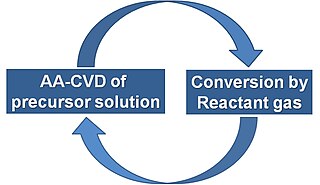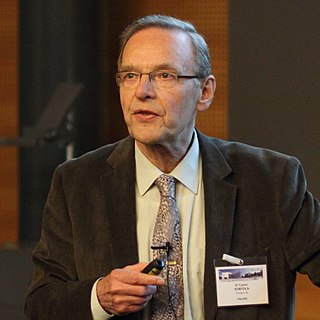Related Research Articles

Argonne National Laboratory is a federally funded research and development center in Lemont, Illinois, United States. Founded in 1946, the laboratory is owned by the United States Department of Energy and administered by UChicago Argonne LLC of the University of Chicago. The facility is the largest national laboratory in the Midwest.
A thin film is a layer of material ranging from fractions of a nanometer (monolayer) to several micrometers in thickness. The controlled synthesis of materials as thin films is a fundamental step in many applications. A familiar example is the household mirror, which typically has a thin metal coating on the back of a sheet of glass to form a reflective interface. The process of silvering was once commonly used to produce mirrors, while more recently the metal layer is deposited using techniques such as sputtering. Advances in thin film deposition techniques during the 20th century have enabled a wide range of technological breakthroughs in areas such as magnetic recording media, electronic semiconductor devices, integrated passive devices, light-emitting diodes, optical coatings, hard coatings on cutting tools, and for both energy generation and storage. It is also being applied to pharmaceuticals, via thin-film drug delivery. A stack of thin films is called a multilayer.

In nanotechnology, nanorods are one morphology of nanoscale objects. Each of their dimensions range from 1–100 nm. They may be synthesized from metals or semiconducting materials. Standard aspect ratios are 3-5. Nanorods are produced by direct chemical synthesis. A combination of ligands act as shape control agents and bond to different facets of the nanorod with different strengths. This allows different faces of the nanorod to grow at different rates, producing an elongated object.
Atomic layer deposition (ALD) is a thin-film deposition technique based on the sequential use of a gas-phase chemical process; it is a subclass of chemical vapour deposition. The majority of ALD reactions use two chemicals called precursors. These precursors react with the surface of a material one at a time in a sequential, self-limiting, manner. A thin film is slowly deposited through repeated exposure to separate precursors. ALD is a key process in fabricating semiconductor devices, and part of the set of tools for synthesizing nanomaterials.
Nanomanufacturing is both the production of nanoscaled materials, which can be powders or fluids, and the manufacturing of parts "bottom up" from nanoscaled materials or "top down" in smallest steps for high precision, used in several technologies such as laser ablation, etching and others. Nanomanufacturing differs from molecular manufacturing, which is the manufacture of complex, nanoscale structures by means of nonbiological mechanosynthesis.
Dieter Martin Gruen is a German-born American scientist, who was a senior member of the Materials Science Division at Argonne National Laboratory. He received B.S. and M.S. (1947) degrees in chemistry from Northwestern University and the Ph.D. (1951) in chemical physics from the University of Chicago.
ASM is a Dutch headquartered multinational corporation that specializes in the design, manufacturing, sales and service of semiconductor wafer processing equipment for the fabrication of semiconductor devices. ASM's products are used by semiconductor manufacturers in front-end wafer processing in their semiconductor fabrication plants. ASM's technologies include atomic layer deposition, epitaxy, chemical vapor deposition and diffusion.

Gradient multilayer (GML) nanofilm is an assembly of quantum dot layers with a built-in gradient of nanoparticle size, composition or density.

A microchannel plate (MCP) is used to detect single particles and photons. It is closely related to an electron multiplier, as both intensify single particles or photons by the multiplication of electrons via secondary emission. Because a microchannel plate detector has many separate channels, it can provide spatial resolution.

Ion layer gas reaction (ILGAR®) is a non-vacuum, thin-film deposition technique developed and patented by the group of Professor Dr. Christian-Herbert Fischer at the Helmholtz-Zentrum Berlin for materials and energy in Berlin, Germany. It is a sequential and cyclic process that enables the deposition of semiconductor thin films, mainly for photovoltaic applications, specially chalcopyrite absorber layers and buffer layers. The ILGAR technique was awarded as German High Tech Champion 2011 by the Fraunhofer Society.
Michael Makepeace Thackeray is a South African chemist and battery materials researcher. He is mainly known for his work on electrochemically active cathode materials. In the mid-1980s he co-discovered the manganese oxide spinel family of cathodes for lithium ion batteries while working in the lab of John Goodenough at the University of Oxford. In 1998, while at Argonne National Laboratory, he led a team that first reported the NMC cathode technology. Patent protection around the concept and materials were first issued in 2005 to Argonne National Laboratory to a team with Thackeray, Khalil Amine, Jaekook Kim, and Christopher Johnson. The reported invention is now widely used in consumer electronics and electric vehicles.

Tuomo Suntola is a Finnish physicist, inventor, and technology leader. He is best known for his pioneering research in materials science, developing the thin film growth technique called atomic layer deposition.

Igor Serafimovich Tashlykov was a Soviet and Belarusian physicist, who was awarded the Doctor of Physical and Mathematical Sciences degree (1989). He was a member of the Belarusian Physical Society (1995). He carried out research at the Research Institute of Applied Physical Problems (APP) of the Belarusian State University, the Belarusian State Technological University, the Maxim Tank Belarusian State Pedagogical University (BSPU).
Molecular layer deposition (MLD) is a vapour phase thin film deposition technique based on self-limiting surface reactions carried out in a sequential manner. Essentially, MLD resembles the well established technique of atomic layer deposition (ALD) but, whereas ALD is limited to exclusively inorganic coatings, the precursor chemistry in MLD can use small, bifunctional organic molecules as well. This enables, as well as the growth of organic layers in a process similar to polymerization, the linking of both types of building blocks together in a controlled way to build up organic-inorganic hybrid materials.

Amanda Karen Petford-Long is a Professor of Materials Science and Distinguished Fellow at the Argonne National Laboratory. She is also a Professor of Materials Science at Northwestern University.
Kawtar Hafidi is a Moroccan-American experimental nuclear physicist and the Associate Laboratory Director for Physical Sciences and Engineering at Argonne National Laboratory. She researches nucleon and nuclear structure using major accelerator facilities, e.g., Jefferson Lab, DESY, and Fermilab. She is also an advocate for diversity and almost became a professional soccer player when she was 16.
Larry A. Curtiss is an American chemist and researcher. He was born in Madison. WI. in 1947. He is a distinguished fellow and group leader of the Molecular Materials Group in the Materials Science Division at the U.S. Department of Energy's (DOE) Argonne National Laboratory. In addition, Curtiss is a senior investigator in the Joint Center for Energy Storage Research (JCESR), a DOE Energy Storage Hub, and was the deputy director of the Center for Electrochemical Energy Science, a DOE Energy Frontier Research Center.
Khalil Amine is a materials scientist at Argonne National Laboratory, an Argonne distinguished fellow, and group leader of the Battery Technology group. His research team is focused on the development of advanced battery systems for transportation applications. In addition to his Argonne appointment, he is an adjunct professor at Stanford University, Imam Abdulrahman Bin Faisal University, Hong Kong University of Science & Technology, King Abdulaziz University, Hanyang University, and Peking University.

Seth B. Darling is the Chief Science & Technology Officer of the Advanced Energy Technologies Directorate at Argonne National Laboratory. He previously served as director of the Center for Molecular Engineering, a research and development organization partnered with the University of Chicago focusing on advanced materials for cleaning water, quantum information science, and polymer science. Darling is also a senior scientist at both the U.S. Department of Energy’s (DOE) Argonne National Laboratory and the University of Chicago’s Pritzker School of Molecular Engineering. He also directs the Advanced Materials for Energy-Water Systems (AMEWS) Center, a DOE Energy Frontier Research Center formed in 2018.
Derived from atomic layer deposition (ALD), sequential infiltration synthesis (SIS) is a technique in which a polymer is infused with inorganic material using sequential, self-limiting exposures to gaseous precursors, allowing for the precise control over the composition, structure and properties of materials. This synthesis involves metal-organic vapor-phase precursors and co-reactants dissolving and diffusing into polymers, interacting with the polymer functional groups via reversible complex formation and/or irreversible chemical reactions yielding desired composite materials, which may be nanostructured. The metal-organic precursor (A) and co-react vapor (B) are supplied in an alternating ABAB sequence. Following SIS, the organic phase can be removed thermally or chemically to leave only the inorganic components behind. The precise control over the infiltration and synthesis via SIS allows the creation of materials with tailored properties like composition, mechanics, stoichiometry, porosity, conductivity, refractive index, and chemical functionality on the nanoscale. This empowers SIS to have a wide range of applications from electronics to energy storage to catalysis. SIS is sometimes referred to as "multiple pulsed vapor-phase infiltration" (MPI), "vapor phase infiltration" (VPI)” or "sequential vapor infiltration" (SVI)".
References
- ↑ "Jeffrey W. Elam | Argonne National Laboratory". www.anl.gov. Retrieved 2019-10-27.
- ↑ "Members – NAISE Institute". www.naise.northwestern.edu. Retrieved 2019-10-27.
- ↑ "Staff Directory | Argonne National Laboratory". www.anl.gov. Retrieved 2020-04-29.
- ↑ "Functional Coatings | Argonne National Laboratory". www.anl.gov. Retrieved 2020-04-29.
- ↑ "Advanced Materials for Energy-Water Systems Center | Our Team | Argonne National Laboratory". www.anl.gov. Retrieved 2020-04-29.
- ↑ "Jeffrey W. Elam | Argonne National Laboratory". www.anl.gov. Retrieved 2019-10-27.
- ↑ "Jeffrey W. Elam". www.aiche.org. 2017-08-07. Retrieved 2020-04-29.
- ↑ "UAH College of Engineering welcomes Dr. Jeffrey W. Elam of Argonne National Laboratory". The University of Alabama in Huntsville. 2016-11-07. Retrieved 2020-04-29.
- ↑ "Argonne invents reusable sponge that soaks up oil, could revolutionize oil spill and diesel cleanup | Argonne National Laboratory". www.anl.gov. 6 March 2017. Retrieved 2019-09-27.
- ↑ Elam, J. W.; Biswas, M.; Darling, S.; Yanguas-Gil, A.; Emery, J. D.; Martinson, A. B. F.; Nealey, P. F.; Segal-Peretz, T.; Peng, Q.; Winterstein, J.; Liddle, J. A. (2015-10-02). "New Insights into Sequential Infiltration Synthesis". ECS Transactions. 69 (7): 147–157. Bibcode:2015ECSTr..69g.147E. doi:10.1149/06907.0147ecst. ISSN 1938-6737. PMC 5424714 . PMID 28503252.
- ↑ "The promise of deep grooves | Argonne National Laboratory". www.anl.gov. October 2018. Retrieved 2020-04-30.
- 1 2 US 9786511,Darling, Seth B.; Elam, Jeffrey W.& Tseng, Yu-Chihet al.,"Sequential infiltration synthesis for advanced lithography",published 2017-10-10, assigned to UChicago Argonne LLC
- ↑ "New Vapor Deposition Method Lets Engineers Build Untraditional Materials". Machine Design. 2018-10-12. Retrieved 2019-09-27.
- ↑ "Oleo Sponge Could Make Oil Spill Cleanup More Efficient". The Wall Street Journal. March 16, 2017. Retrieved September 25, 2019.
- ↑ Mane, Anil U.; Peng, Qing; Elam, Jeffrey W.; Bennis, Daniel C.; Craven, Christopher A.; Detarando, Michael A.; Escolas, John R.; Frisch, Henry J.; Jokela, Slade J.; McPhate, Jason; Minot, Michael J. (2012-01-01). "An Atomic Layer Deposition Method to Fabricate Economical and Robust Large Area Microchannel Plates for Photodetectors". Physics Procedia. Proceedings of the 2nd International Conference on Technology and Instrumentation in Particle Physics (TIPP 2011). 37: 722–732. Bibcode:2012PhPro..37..722M. doi: 10.1016/j.phpro.2012.03.720 . ISSN 1875-3892.
- ↑ "Nanocomposite Coatings with Tunable Properties Prepared by Atomic Layer Deposition". Sigma-Aldrich. Retrieved 2019-10-27.
- ↑ "MCP / Microchannel Plate / Photon and Electron Amplification". Incom. Retrieved 2019-09-27.
- ↑ Adams, Bernhard W.; Attenkofer, Klaus; Bogdan, Mircea; Byrum, Karen; Elagin, Andrey; Elam, Jeffrey W.; Frisch, Henry J.; Genat, Jean-Francois; Grabas, Herve; Gregar, Joseph; Hahn, Elaine (2016-03-06). "A Brief Technical History of the Large-Area Picosecond Photodetector (LAPPD) Collaboration". arXiv: 1603.01843 [physics.ins-det].
- ↑ US 8969823,Elam, Jeffrey W.; Mane, Anil U.& Peng, Qing,"Microchannel plate detector and methods for their fabrication",published 2015-03-03, assigned to UChicago Argonne LLC
- 1 2 US 10131991,Elam, Jeffrey W.&Libera, Joseph A.,"Method for depositing transparent conducting oxides",published 2018-11-20, assigned to UChicago Argonne LLC
- ↑ Libera, Joseph A.; Hryn, John N.; Elam, Jeffrey W. (2011-04-26). "Indium Oxide Atomic Layer Deposition Facilitated by the Synergy between Oxygen and Water". Chemistry of Materials. 23 (8): 2150–2158. doi:10.1021/cm103637t. ISSN 0897-4756.
- ↑ "Jeffrey Elam - Google Scholar Citations". scholar.google.com. Retrieved 2019-10-27.
- ↑ Groner, M. D.; Fabreguette, F. H.; Elam, J. W.; George, S. M. (2004-02-01). "Low-Temperature Al2O3 Atomic Layer Deposition". Chemistry of Materials. 16 (4): 639–645. doi:10.1021/cm0304546. ISSN 0897-4756.
- ↑ "Jeffrey W. Elam Inventions, Patents and Patent Applications - Justia Patents Search". patents.justia.com. Retrieved 2020-02-02.
- ↑ "Awards". ald2018.avs.org. Retrieved 2019-09-27.
- ↑ "Congratulations to winners of 2019 Argonne Commercialization Excellence Awards". Argonne Today. May 21, 2019. Retrieved September 25, 2019.
- ↑ US 10177365,Mane, Anil U.; Elam, Jeffrey W.& Park, Joong Sunet al.,"Metal fluoride passivation coatings prepared by atomic layer deposition for Li-ion batteries",published 2019-01-08, assigned to UChicago Argonne LLC
- ↑ US 8980418,Darling, Seth B.; Elam, Jeffrey W.& Tseng, Yu-Chihet al.,"Sequential infiltration synthesis for advanced lithography",published 2015-03-17, assigned to UChicago Argonne LLC
- ↑ US 8921799,Elam, Jeffrey W.&Mane, Anil U.,"Tunable resistance coatings",published 2014-12-30, assigned to UChicago Argonne LLC
- ↑ US 8951615,Elam, Jeffrey W.&Yanguas-Gil, Angel,"Doping control by ALD surface functionalization",published 2015-02-10, assigned to UChicago Argonne LLC
- ↑ US 8969823,Elam, Jeffrey W.; Mane, Anil U.& Peng, Qing,"Microchannel plate detector and methods for their fabrication",published 2015-03-03